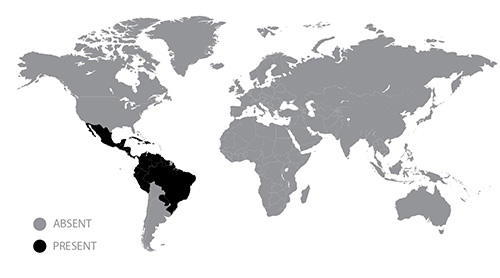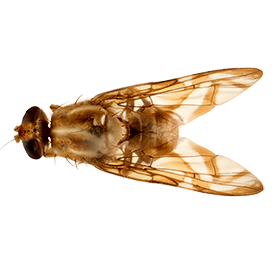Diagnosis
Morphological – adult
A species in the fraterculus-group.
Features include:
- frons without brown markings except ocellar tubercle
- mesonotum yellow/orange with three pale postsutural vittae
- scutum posteriorly without brown markings, without brown vittae
- scutellum entirely yellow or with dark markings only on extreme base of disk
- subscutellum entirely yellow to orange, or yellow to red-brown medially, dark brown laterally
- mediotergite yellow to red-brown medially, dark brown laterally, or entirely yellow to orange
- wing with typical Anastrepha pattern (S-band complete or at most interrupted at crossvein r-m, C-band and at least proximal arm of V-band present), C-band and S-band connected, V-band proximal arm as dark as apical half of S-band, connected anteriorly to S-band along vein R4+5 or in cell r2+3, V-band distal arm complete and connected to proximal arm of V-band
- abdominal tergites without brown markings
- aculeus length 1.3 – 1.75 mm; aculeus tip length 0.15 – 0.25 mm
- aculeus tip width 0.08 – 0.12 mm
- lateral margins of aculeus tip not curved dorsally or slightly curved dorsally.
Morphological – larvae
Information not available.
Molecular
DNA barcoding
BOLD reference data available, but cannot be distinguished from A. fraterculus, A. distincta, A. ludens, or A. suspensa.
PCR-RFLP Test 1
BsrI: Does Not Cut
HinfI: 270, 450
HhaI: Does Not Cut
Sau3AI: 200, 450
SnaBI: Does Not Cut
SspI: 150, 550
Vspl: 550
Approximate ITS1 fragment length – gel: 670 bp
PCR-RFLP Test 2
HinfI, Sau3A and SspI are diagnostic
HinfI: 610, 270, 240, 150, 110, 80, 70
Sau3A: 770, 450, 200-170, 110
SspI: 1400, 110
Gallery
- link
Anastrepha obliqua - Entire Body Dorsal Classic AOB001
- link
Anastrepha obliqua - Entire Body Lateral Classic AOB001
- link
Anastrepha obliqua - Head Classic AOB001
Host Range
Anastrepha obliqua has been recorded from more than 60 hosts across 24 families, including:
- Anacardiaceae
- Ebenaceae
- Malpighiaceae
- Moraceae
- Myrtaceae
- Oxalidaceae
- Passifloraceae
- Rosaceae
- Rubiaceae
- Rutaceae
- Sapotaceae
It is an important pest of mangoes, guava, rose apple and Spondias (pers. comm. Drew 2010). For a full list of recorded hosts see CABI (2007).
Major commercial hosts (CABI 2007):
- Mangifera indica (mango)
- Spondias purpurea (purple mombin)
Distribution
Throughout the greater and lesser Antilles, Jamaica, Trinidad, the Rio Grande Valley of Texas, Mexico to Panama, Venezuela, Ecuador, and the vicinity of Rio de Janeiro, Brazil (UF and FDACS 2009).
It is one of the most widely distributed Anastrepha species, having been recorded from Florida (USA), Southern and Central America and the West Indian islands.

Similar species
Anastrepha obliqua closely resembles A. fraterculus and A. suspensa.
The aculeus is subtly different from A. fraterculus and A. suspensa, having lateral serrations on more than two-thirds of the tip in contrast to those of the other species, where they are limited to the apical two-fifths to three-fifths of the tip.
In A. obliqua, the tip also is relatively wider at the base of the serrations compared with the width at the genital opening. The white medial vitta on the scutum is wider in A. obliqua than in A. suspensa and A. fraterculus, and no scutoscutellar black spot or lateral dark marks on the subscutellum are present, although the mediotergite usually has a lateral dark stripe (Foote, Blanc and Norrbom 1993).
Additional information
Recent studies have revealed discrepancies between mitochondrial and nuclear DNA data with respect to intra/inter-species relationships within this species. Mitochondrial data reveals significant diversity which is not reflected in the nuclear genome (Scally et al. 2016).
Pest Status
- Exotic
- Anastrepha obliqua is one of the most important fruit fly pests of mango in Central and Southern America
Attractant/Lure
No known record, but can be captured in traps emitting ammonia.

